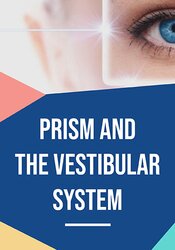

Vestibular function goes hand in hand with visual function. When you understand how these systems are intertwined, you can immediately resolve vision-related health and function concerns in many clinical populations: headache, diplopia (double-vision), blur, reading and learning deficits and discomfort, attention problems, photophobia (light sensitivity). Explore:
- How visual-vestibular dysfunction impacts brain injury treatment
- The role of oculomotor and vestibular dysfunction in reading disability and praxis
- Testing techniques that you can modify in your own practice: BPPV, Post-rotational nystagmus, peripheral vs. central visual fields, strabismus and other ocular restrictions.
- Opportunities for “coordinated firing” with multimodal experiences to promote the integration of visual and vestibular function.
- Use of prism in visual perceptual, visuomotor, and oculomotor therapies
- Training full body awareness, sensorimotor conditioning, visual-vestibular patterning with evidence-based tools
Accelerate and bolster outcomes in visuomotor, oculomotor, and perceptual training with simple tests and techniques you can implement right away.
Planning Committee Disclosure - No relevant relationships
All members of the PESI, Inc. planning committee have provided disclosures of financial relationships with ineligible organizations and any relevant non-financial relationships prior to planning content for this activity. None of the committee members had relevant financial relationships with ineligible companies or other potentially biasing relationships to disclose to learners. For speaker disclosures, please see the faculty biography.
NOTE: Tuition includes one free CE Certificate (participant will be able to print the certificate of completion after passing the online post-test (80% passing score) and completing the evaluation). Instructional methods will include PowerPoint, didactic lecture, and others.
Continuing Education Information: Listed below are the continuing education credit(s) currently available for this non-interactive self-study package. Program content is reviewed periodically per accrediting board rules for currency and appropriateness for credit. Credit approvals are subject to change. Please note, your state licensing board dictates whether self-study is an acceptable form of continuing education. Please refer to your state rules and regulations. If your profession is not listed, please contact your licensing board to determine your continuing education requirements and check for reciprocal approval.
For other credit inquiries not specified below, please contact info@pesi.com or 800-844-8260 before purchase.
Materials that are included in this course may include interventions and modalities that are beyond the authorized practice of your profession. As a licensed professional, you are responsible for reviewing the scope of practice, including activities that are defined in law as beyond the boundaries of practice in accordance with and in compliance with your profession's standards.
For Planning Committee disclosures, please see the statement above. For speaker disclosures, please see the faculty biography.
CE credit is available. This course consists of 4.0 continuing education clock hours for Arizona OTs and OTAs. The Arizona Board of Occupational Therapy Examiners (R4-43-203) confirms acceptance of continuing education programs relevant to occupational therapy that are approved by the American Occupational Therapy Association (AOTA).
PESI, Inc. is an approved provider with the Florida Board of Occupational Therapy. Provider Number #50-399. This course qualifies for 4.0 self-study continuing education credits.

CE credit is available. This self-study course consists of 4.0 continuing education credit hours for Alaska Physical Therapists. The Board Rule 12 AAC 54.420 confirms acceptance of continuing education programs that are recognized by other state physical therapy licensing boards. PESI, Inc. is recognized by the Physical Therapy Board of California as an approval agency to approve providers.
CE credit is available. The Arizona State Board of Physical Therapy recognizes continuing competence activities that have been approved by any state PT association or national medical/health care association (e.g., AOTA, ASHA). This self-study activity consists of 4.0 clock hours of instruction applicable for physical therapists.

PESI, Inc. is recognized by the Physical Therapy Board of California as an approval agency to approve providers. This self-study lecture qualifies for 4.0 continuing competency hours.
This self-study course consists of 4.0 clock hours of instruction that is applicable for physical therapists. CE requirements for physical therapists vary by state/jurisdiction. Please retain the certificate of completion that you receive and use as proof of completion when required.
PESI, Inc. is a Registered Physical Therapy Continuing Education Sponsor through the State of Illinois Department of Financial and Professional Regulation, Division of Professional Regulation. License #: 216.000270. This self-study course qualifies for 4.0 CE credit hours.
CE credit is available. This self-study course consists of 4.0 continuing education credit hours for Kentucky Physical Therapists. The rule under 201 KAR 22:045, Section 2, (2)(a) states that category 1 continued competency credits can be earned from providers approved by another physical therapy licensing agency. PESI, Inc. is a Registered Physical Therapy Continuing Education Sponsor through the State of Illinois Department of Financial and Professional Regulation, Division of Professional Regulation. License #: 216.000270.
PESI, Inc. is recognized by the New York State Education Department, State Board for Physical Therapy as an approved provider for physical therapy and physical therapy assistant continuing education. This self-study course qualifies for 5.0 contact hours.
PESI, Inc. is an approved provider with the Illinois Division of Professional Regulation, Provider Number: 216.000270. This intermediate course is approved by the North Carolina Board of Physical Therapy Examiners by virtue of PESI Inc. approved provider status with the Illinois Division of Professional Regulation. This course qualifies for 4.0 continuing education hours.
CE credit is available. This asynchronous activity consists of 4.0 continuing education credit hours for Oklahoma Physical Therapists. Oklahoma Administrative Code 435:20-9-3.1 confirms acceptance of continuing education programs offered by providers approved by other state physical therapy licensing boards. PESI, Inc. is a Registered Physical Therapy Continuing Education Sponsor through the State of Illinois Department of Financial and Professional Regulation, Division of Professional Regulation. License #: 216.000270.
The Pennsylvania State Board of Physical Therapy recognizes approval by all other state boards. This self-study activity consists of 4.0 clock hours of instruction that is applicable for physical therapists.
This self-study activity is provided by the Texas Board of Physical Therapy Examiners Accredited Provider #2406032TX and meets continuing competence requirements for physical therapist and physical therapist assistant licensure renewal in Texas. Instructional Level: Advanced. This activity will provide 4.0 CCUs. The assignment of Texas PT CCUs does not imply endorsement of specific course content, products, or clinical procedures by TPTA or TBPTE. Full attendance is required; no partial credits will be offered for partial attendance.
This course is designed to meet the Utah DOPL Rule R156-24b-303b.2.c.iv - A commercial continuing education provider providing a course related to the practice of physical therapy. Please retain a copy of the advertising brochure and your certificate of completion to provide to your board should this be requested of you. This self-study activity consists of 4.0 clock hours of continuing education instruction.
CE credit is available. This course consists of 4.0 continuing education credit hours for Vermont Physical Therapists. The Board confirms acceptance of continuing education programs that are recognized by other state physical therapy licensing boards. PESI, Inc. is a Registered Physical Therapy Continuing Education Sponsor through the State of Illinois Department of Financial and Professional Regulation, Division of Professional Regulation. License #: 216.000270.
CE credit is available. This self-study course consists of 4.0 hours of type 2 continued competency credit for Virginia Physical Therapists and Physical Therapy Assistants. Regulation 18VAC112-20-131, Section B, (2) states that up to ten type 2 continued competency credits can be earned by completing independent study activities related to the clinical practice of physical therapy.

PESI, Inc. is accredited by the Accreditation Council for Continuing Medical Education to provide continuing medical education for physicians. PESI, Inc. designates this enduring material for a maximum of 4.0 AMA PRA Category 1 Credit(s)™. This activity was originally recorded on 1/2/2023. It was last reviewed on 3/6/2023 and is valid until 03/06/2026.
Physicians should only claim credit commensurate with the extent of their participation in the activity. You are required to successfully complete and submit a post-test prior to receiving a certificate of completion.
This self-study activity qualifies for 4.0 continuing education clock hours as required by many national, state and local licensing boards and professional organizations. Save your activity advertisement and certificate of completion, and contact your own board or organization for specific requirements.
| File type | File name | Number of pages | |
|---|---|---|---|
| Manual - Prism and the Vestibular System (22.8 MB) | 41 Pages | Available after Purchase | |
| Printable Guide (3.6 MB) | 36 Pages | Available after Purchase |

Charles Boulet, BSc, BEd, OD, has been a loud advocate for essential vision care for underserved populations and was instrumental in promoting Alberta’s Child Vision Assessment Act in 2014, which sought to achieve common vision exams for all children in the province. Along with his clinical work, Dr. Boulet is involved with ongoing research and advocacy with professionals from around the world, including a handful of publications and a growing library of online content.
Speaker Disclosures
Access never expires for this product.
Visit our FAQ page at www.pesi.com/faq or contact us at www.pesi.com/info
Prism Goggles / Yoked Prism, weighted blankets, bare feet, sit/bouncing balls, ‘Bosu’ or standing balls, cardboard tubes, ‘plus’ and ‘minus’ lens flippers/trial frames up to +/- 2D, large mirrors, laser pointers, anaglyphic filters, penlight, pens.
Satisfaction Guarantee
Your satisfaction is our goal and our guarantee. Concerns should be addressed to: PO Box 1000, Eau Claire, WI 54702-1000 or call 1-800-844-8260.
ADA Needs
We would be happy to accommodate your ADA needs; please call our Customer Service Department for more information at 1-800-844-8260.
PESI Mobile App
Access CE trainings on your phone or tablet through our free mobile app. Choose video or audio-only versions of online courses from the world’s best instructors, and complete your CE requirements anywhere, anytime, at your own pace.
Please wait ...